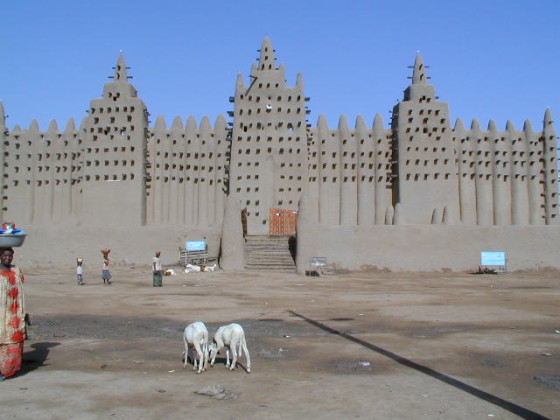Welcome to the small town completely soaked in an unusual mud and brick architecture! Officially known as Djenne, this is a legendary town that is the most ancient site in the sub-Saharan Africa, which is nestled at the Inner Niger Delta’s southern end in central Mali. Settled at 222 miles from Timbuktu, the town was set in 800 AD by the merchants close to the 250 BC site of a city. Since the, it flourished as a vital place of trade as well as learning for the Sudan desert traders. Today, Djenne is an agricultural town whose vitality has now diminished. However, tourism has flourished here because of the many wonderful instances of Muslim structural design of which the Great Mosque is a worth seeing monument.
The mosque is erected on a raised platform and is accessible via a six set of stairs. The complete structure boasts a trapezoidal plan with the main entry on the north. However, the most appealing draw is its outer walls that are made from the mud bricks baked in sun (mortar) as well as mud plaster (as a coating) due to which the exterior gain a broadly carved appearance. In addition, these walls also boast a lot of rodier palm sticks that are called toron stretching up to 2 feet from the ground as well as acting as the basis for preservation. There are ceramic half-pipes from the roofline that make the rain water to descend down and that too without touching the walls. These ceramic caps are always made by the ladies, which upon removal at night can facilitate ventilation within the monument. It is seriously this wonderful arrangement that has made this huge structure to survive until today.

Inside the Djenne Mosque, a qibla or prayer wall facing Mecca represents the devotion to the most holy pilgrimage destination of the Muslims. Here, there are three soaring minarets on whose top resides the spires in cone shape. Each of the corners boasts oblong buttresses that soar with pinnacles. Look for a mihrab in the three towers here of which the one is at the larger tower from where the prayers are conducted. In its right is the pulpit where the discourse is given on Friday. A narrow opening from the ceiling here is connected with a small room from where the words are recapped so that the outside folks can hear.
At the rear of the qibla, most of the area is occupied by the prayer hall of 90 pillars, which can hold 3000 folks. Roof is composed of the rodier palm, while the floor is quite sandy, and that there are 9 walls with arches pointing towards the roof. In the west, the inner courtyard can be seen, which is flanked by galleries with arched openings. There is a special gallery for ladies in the west. Currently, only Muslims can enter the mosque, while the rest can only wonder from outside.
Come here in Spring when the monument is replastered with the help of the young ones. This itself is a festival known as crepissage that is fully of fun, messiness, and excitement.
Besides the mosque, the other highlight is the Grand Marche – Monday Market in front of the mosque. It will make you experience the original vibes of the ancient market where the Saharan camel caravans came here to supply salt after traveling via the desert. Today, you will find many traders who come here from miles away to sell their produce.
Look for the Jenne-Jeno ruins that are of the original town of Djenne at 3 km, which thrived during the 300 BC. Interestingly, there is also the tomb of a young girl at Tapama Dienepo at the southern rim. As per the legend, she voluntarily gave up her life in the 19th century after the declaration of corruption of town via a religious leader.
The best way to come here is via a taxi from Mopti that reaches in 2 hours. Come in August/September when the town becomes a scenic island as the rains are about to halt. For stay, choose from Auberge le Maafir, Chez Baba, Le Campement de Djenne (mostly preferred), and Hotel Tapama.